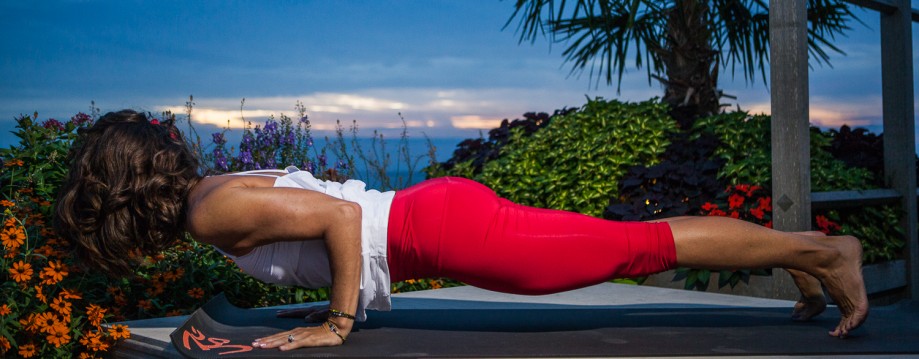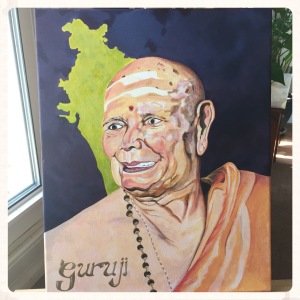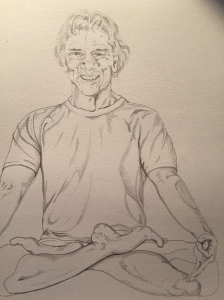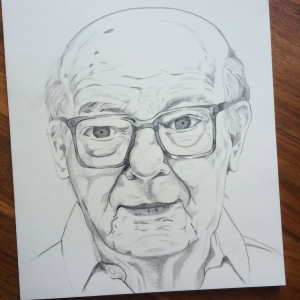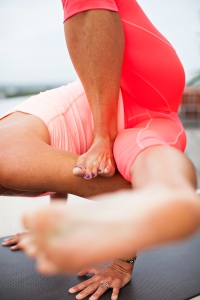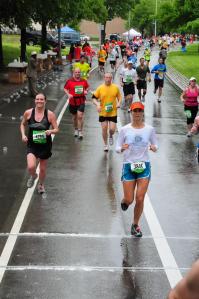Just the other day when I was teaching a class, I compared doing an hour and a half of yoga to that of running 9 miles. Now anyone who has ever run 9 miles is thinking it’s an over statement,…
Introspection
I have been absent from the blog-o-sphere for a while, but never absent from my yoga practice. I have a few pieces on the back burner, but in the meantime here is some food for thought from my little heart to yours. I hope you enjoy.
Honoring thy teacher
I’m sorry that I have taken a break from blogging, but I have been pursuing other forms of creative expression, and my dog, Ginger got very sick for several months, but she is kicking cancers butt. There are so many ways that I enjoy expressing myself and I found great joy in bringing my old profession and hobby back to life in a way that still allowed me to showcase my dedication to yoga, and to all the great teachers that have influenced me over the years. I apologize for my absence, but I know we can all relate to the feeling that there are only so many hours in the day, and they never seems to be enough. I have a stack of notes with ideas scribbled on them for future blogs that I still intend to write. I hope you enjoy why I took a break. These drawings and paintings are how I have been spending my spare time. I have been refining an old skill I once had and used to thoroughly enjoy.
Even in Art, Pattabhi Jois had it right “Practice, Practice, Practice and all is coming.” Art is a skill like anything else that gets better with practice. And it is also true that yoga and art are best maintained by remembering that they are “99%practice and 1% theory”, Because no matter how much I might read about how to paint a portrait, the only real thing that is going to get me there is to practice painting portraits. So this is my yoga practice off the mat and in the world, I hope you enjoy seeing the other ways I spend my time.
It’s a good day for a parade!
If I move left, you move left, and if you move right, I move right. If the group moves up we all go with it. We bob and weave, we ebb and flow, we juke and jive, we move together in all directions and pretty much in unison. There is a great comfort in this uniformity. It provides a certain degree of mental safety. There’s a sense of stability because we are all doing the same thing. It’s nice to know the people surrounding me made the same decision I did today – do your practice. That you packed your yoga bag just as I did this morning to ensure there wouldn’t, couldn’t be any cop-out. That you are breathing, the way I am breathing, that you will struggle as I will struggle, that you will surrender as I will surrender. Not all of these things will happen at the exact same time, but they are bound to happen over the course of our time together, and this provides me great comfort.
Ashtanga yoga does it right. Uniting like-minded people in a room for an hour and half helps us see our similarities instead of our differences. Our community will be built. Our tribe is being formed. You’ve heard the proverb, “It takes a village.” this is my village. This creation of commonality could be the cure for what divides us and creates war.
I often say to my students “that you have at least one thing in common with everyone one in this room today, and that is – you wanted to do your practice.” You all woke up with the same plan – “Must practice yoga!” Go beyond that and see that you have even more in common with your classmates. There may be several of you that are mothers, there may be some of you that are runners, some of you raised by a single parent, some with fear of heights, some with a love of classical music, some that enjoy the same beer and some that have fur-children. If we were to stop everyone at the door and survey each person we could probably lump you together in a bunch of different ways. If we could make you realize all the things you have in common, it would help you feel connected to something that doesn’t have limits. This infinite possibility of connection is bigger than we realize. The potential that comes out of working together way out weighs the struggle you feel when working against each other.
In life, we have many circles. Little communities that make us feel part of something bigger. But why is it that we aren’t feeling more united? We feel that technology is separating us more and more, but everyday I see people uniting in their yoga practice. Especially if its ashtanga yoga, and even more so if its second series that they are practicing. Almost everyone needs help with Supta Vajrasana. I love that we are there for each other with this pose and that there is a forced eye to eye contact that happens on that last exhale up out of Little Thunderbolt. Yoga has a word for all this uniting we experience in and amongst our yoga friends – sangha. No matter the word, sangha, tribe, school, or parade it means the same thing – stick together.
Nature has been on to this little hidden secret for years. Fish stick together in a school, lions stick together in a pride, when crows stick together it’s called a murder, when giraffes stick together it’s called a tower, and when elephants stick together it’s called a parade. This should make us realize that we are stronger as a pack, than we are as individuals. I know I feel this way when I practice yoga with my tribe. Animals realize they are safer in numbers, and ashtangi’s do too.
See yoga’s big goal, or its climax to speak of, is oneness. This union with just one thing and this one thing is powerful enough to make us feel complete, whole, connected, whatever you want to call it. Pattbhi Jois often said “Looking…only God seeing.” It’s cool if it’s not “God” for you, but it is a union to something. When we do our OM we resonate with this one universal sound, and we realize everything vibrates together at some level. Everything and everyone is connected at some level. Recently my sister-in law realized she had met my husband about 15 years before I met him. She was on vacation in Myrtle Beach, SC with her family and my husband flew her and her sister on a parasail ride up and down the coast. She even has a picture to prove this chance meeting. We say it’s a small world, but is it really? I have several more stories of this kind of chance meeting, as I am sure you do too. It’s time that we realize we are all connected.
I took a workshop years ago with Shiva Rae, it was her trademark trance dance workshop. She had us do this thing that I was positive was never going to work. She had us move around a small yoga room, spinning in circles with our arms out for 10 mins. During that 10 minutes she said ” just keep moving by looking for the open spot and you won’t bump into each other.” You know what? It worked! What if practicing yoga could be that simple “Just look for the open spot, and move there.” Just like looking for a parking spot at the grocery store. Find the opening, right? Because that’s where the light shines in.
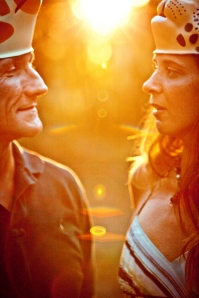 If all of us show up on our mats and look for the opening where the light shines in there is bound to be a radiance equal to that of the sun, where for a moment you find yourself completely entranced with the people surrounding you. That you find yourself in a trance dance with your school of yogi’s – flowing on the same current, the same vibration, going in the same direction and moving as one. That at least once during the practice maybe more, you will feel like one brilliant light, you will sound like one giant lung, and you will feel like a school, or a pride, or a flock. If it’s a really good day you might feel like a parade.
If all of us show up on our mats and look for the opening where the light shines in there is bound to be a radiance equal to that of the sun, where for a moment you find yourself completely entranced with the people surrounding you. That you find yourself in a trance dance with your school of yogi’s – flowing on the same current, the same vibration, going in the same direction and moving as one. That at least once during the practice maybe more, you will feel like one brilliant light, you will sound like one giant lung, and you will feel like a school, or a pride, or a flock. If it’s a really good day you might feel like a parade.
Fast food yoga anyone?
Yoga has succumb to the fast food influence. Everyone wants the cool poses and they want the cool poses NOW! People would also like to pay as little as possible for their time spent doing these trick postures. These circus trick postures seem to be as tempting as the little plastic super hero figurine in a happy meal. The “high” from these postures is addictive, and it has power that can alter your life. But not all things we do are good for us. The surgeon general warns us that cigarette smoking is bad, yet people still do it. So what are we to do when we feel tempted to only be pleasure seekers and pain avoiders? Always start with awareness.
We have gone mad with yoga in the United States with classes called happy hour, wisdom warriors and rockasana. These classes branded with big promises of happiness, knowledge and the “Cool” factor. If anything, when I head to a yoga class I am usually looking for less, not more. I want to walk away feeling liberated of the heavy load I’m carrying. I don’t want to worry about how cool I look, while losing a percentage of my hearing because I’m jamming out to Eminem in Triangle pose. What has happened to yoga in America? In my opinion, it has just become another thing we have tried to control, stamp a label on, and declare it ours. Now let’s see how cheap we can make it, how trendy and nutritionally devoid. Sounds a lot like fast food doesn’t it?
Now I don’t want to be the Grinch that stole Natarajasana from the towns people, but I wouldn’t mind stealing a few things away from this Americanized yoga. Like Loud music, cute little names for the postures (like fallen angel and baby grasshopper), lavender-scented hand towels, foot rubs in savasana, and arm balances. Now hear me out, I know I few of you just gasped; If you like loud music, listen to it in your car on the way to yoga because it’s not possible to listen to your breathing in a Rockasana class. Which is the primary tenet of yoga’s methodology. If you like foot rubs, pay a trained massage therapist to assist you in your healing. If you like lavender-scented towels then launder your clothes with a little lavender added to it. Remember the 4th limb of yoga Pratyahara – sense withdrawal, not sense overload. And if you like your practice to have a heavy portion of arm balancing, this could be a good time to examine why? Has your yoga become a place for an addiction? Is this kind of yoga possibly feeding narcissism?
I know arm balancing postures are very empowering! I’m not trying to say that they have no place in yoga, as they have many benefits, different for each student. I’m not saying that we should take any of these things I speak of away from the students. But teachers should ask the question “Am I teaching this class to be popular? to be famous? to fill my ego and get my number of followers to a million on social media?” or “Am I teaching it for the people who show up? Evaluating their ability and analyzing their patterns of weakness and or stubbornness. Is it for me, or is it for them?” No doubt there is a “high” that can come with being up at the front of the room demonstrating great skill in front of 40 people, their eyes wide from being enamored by your grace and beauty. It is this “high” we must be careful with. I took a great workshop from Sean Corne, a very beautiful and gifted teacher. She said, “do you want to be popular, or do you want to be a good teacher?” That question has always stuck with me through 14 years of teaching. I try to check my motive behind my teaching with that question. Sometimes you have to sacrifice the trick poses so that you can teach an intelligent sequence that informs and educates as you go.
Some teachers do a beautiful job, sequencing, cueing and supporting the student, but too many times I have seen the opposite – where 80% of the students are at a basic level ability, but the teacher is handing out advanced level postures. 20% of the students achieve the asana, 50% are plain sitting it out, 10% are putting in good effort and 20% are setting up patterns of future injury. This is not good teaching. I believe the source of this kind of teaching has to do with the fast nature of the industry now. Yoga studios are graduating large groups of trainees every couple of weeks. This side of the industry is becoming like an assembly line. The fact is that you can get certified to teach yoga in 1 month, accumulating as little as 200 hours of knowledge, and in the end all you have to do is pay your 95$ to Yoga Alliance. Which only proves you finished the training. It proves nothing of your knowledge or commitment. Graduates do not have to take a test, or submit competency of any kind to the governing body of yoga. This seems like a slippery slope for yogas future.
In traditional ashtanga yoga, a teacher can hold you back from future postures until you have done the work necessary to move your body into and out of it in a safe and appropriate way. This is just one of the reasons why I love Ashtanga and its old school principals. There is nothing wrong with taking things slow. I love that my Ashtanga yoga teacher, who I greatly respect, doesn’t even offer a 200 hr course. He offers instead two separate 100 hour trainings and they are spaced a year apart. This helps to ensure that the student stick with it for at least a year. It proves a teacher’s level of dedication when they are willing to wait, continue to practice and come back a year later to complete the course.
Now a days, a student can start yoga in February, practice on and off for a couple of months, take a 1 month teacher training, and maybe a few months later they open their own studio and begin teaching something that they have only just begun. This would be like opening a restaurant because you own some cook book’s. Or opening a doctor’s office because you are really proficient at taking temperatures, and giving boo boo’s kisses. There is a reason why so many professions take years of schooling. Many have boards that you must pass before you can practice your profession. It’s the reason why restaurants receive reviews from the board of health, to help prevent you from getting bad food. Who is going to protect the public from getting bad yoga?
Change will come when people no longer want it fast and cheap. When they decide to no longer be glazed over by the shiny big promises of the cool poses and fancy tricks, but start to enjoy the simplicity of what yoga can do for you – like a better nights sleep. Maybe it’s time to teach “bran muffin-nutritionally packed” kind of yoga, with thoughtfulness to the actual students that show up and organized progressively towards a specific posture. Instead of teaching a “donut-empty of nutrients” kind of class, devoid of any substantial thought and or observation to the students participation and progression. These kind of classes that has as many arm balances thrown in as possible, with each one behaving like a sugar spike the way nutritionally devoid food behaves. These sugar spike postures are bound to create a big crash, or as I have seen – a real crash to the very hard and unforgiving floor.
Yoga is a lifelong journey that requires time on a yoga mat – alone and with a professional teacher. It requires time to digest and adapt the information. It requires the student making wise choices to practice with qualified teachers who have done their time on the mat. So don’t be afraid to ask your teacher qualifying questions like “How long have you been teaching?”, or “With whom have you studied?” There are enough qualified, elder and senior teachers out there – with more than 10/15 years teaching experience. You don’t have to settle for the studio that is the closest, the cheapest, or even the fanciest. That could be buying you yoga devoid of any expertise.
Keep your awareness sharp and make sure you aren’t falling for nutritionally empty yoga. Be ware of gimmicks. Play with those postures within reason. Stay aware of some of the poisons there are in a yoga practice like aversion and attachment.
When are you an addict? When you are so attached to something that it causes you great suffering to go without. It’s easy to get addicted to just about anything. By constantly re-examining your motives you will keep your addictions in check. Go for sustenance, commit to the long haul and enjoy the subtle flavorings of a good practice with a very qualified teacher. Sometimes the best flavors come out of a long slow cooking process. Soak in the wisdom from the years some of these teachers have invested. Be willing to let your yoga progress slowly at times. A good teacher will help you do that by calling you out on your aversions, and your attachments. And always try to remember this simple advice from the yoga sutra’s.
Sutra 1.12 Abhyasa Vairagyabhyam Tannirodhah. Mental fluxes are restrained by practice and non-attachment
Sutra 1.14 Sa tu dirgha kale nairantarya satka-rasevito drdhabhumih. Practice becomes firmly grounded when well attended to for a long time, without break and in all earnest.
Sutra 2.3 Avidyasmita raga dvesabhinivesah klesah – There are five primal causes of suffering: ignorance of your True Self and the value of spirituality, egoism and its self-centeredness, attachment to pleasure, aversion to pain, and clinging to life out of fear of death.
A very exciting workshop!
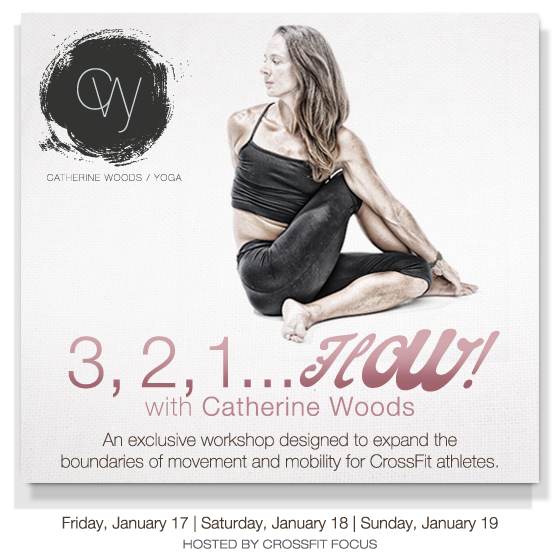
CrossFit and Yoga, do they work? Absolutely! So many of their principles align. CrossFit believes in having a coach to call you out on bad form and impatience, and yoga believes in having a principal teacher to do the same thing. Both practices believe in showing up to your yoga Studio, and or your Box 6 days a week. No excuses, get it done. They both believe that good form – creates good function. They both believe in not cheating through your weakness to advance. They both believe in learning to use your body as an instrument for exploration of your limits. Because of all these similarities, and more I am excited to be teaching the CrossFit Community what I have learned from being a dedicated student and teacher of yoga for the past 14 years.
I have always been into fitness. From a very young age I wanted to be a bodybuilder. I grew up in the 80’s when Cory Everson was quite the fitness star of her time. I worked hard then, and continue to do so now. I have become a body builder just by a different definition, instead of lifting weights to build my body, I lift myself up off the ground into all sorts of yoga postures. I am making my best possible body built to handle anything.
I have been a runner pretty much since I could walk, well not really, but you know what I mean. I have been a runner longer than I have been a yogi. I have stayed injury free through four marathons because of my years of having a rigorous yoga practice. If you’ve read my past blogs you know that I find parallels between running and yoga. Now I look forward to finding the parallels between yoga and CrossFit. I intend to share all of my hard-earned breakthroughs with the fitness industry, or as I like to call it the “Grateful I have this body industry.”
The reality is the body was designed to do great things. If this weren’t true there wouldn’t be an olympic swimmer breaking a record right now, there wouldn’t be an olympic dead lift weight being conquered this very moment and there sure as heck wouldn’t be another great athlete being voted into another Hall of Fame. The human body is so exquisite and resilient. It’s sadly resilient to obesity as much as it is resilient to being pushed into new feats of disbelief. I have been witnessing feats of strength and flexibility in yoga for 14 years now from my body and others. I have overcome adversities, from a full ruptured L5/S1 6 years ago, to running 3 marathons since then. I don’t accept “no” as a final answer.
If you are not yet inspired to do great things with your body then maybe it’s time to get up and get going to your closest Box or Studio. Your potential is limitless, discover this for yourself.
If you are interested in hosting a similar workshop at your CrossFit Box, contact me for details. If you are interested in attending this workshop see below.
http://www.crossfitfocus.com/events/
January 17th – 19th 2014
Pittsburgh, PA
Registration is OPEN!
I sea life is urching you.
I feel giddy with excitement whenever I find the skeleton of a sea urchin that has washed ashore. This is such a big deal to me that I actually have a little sea urchin dance that I do that my husband just shakes his head at. I think the fact that their shell is less than a millimeter thick and is delicate beyond measure leaves me feeling blessed to have found it. It’s quite a miracle that it managed to wash ashore in one piece when you think about the power of the ocean and its constant rhythm. Wave after wave thrusting into the sandy surface with the yanking force it has of pulling all back out to sea that don’t resist. I feel like each and every one I find is a sacred gift from the earth, something to be cherished. I have a bowl filled with their little delicate bodies. When I stare at this bowl I always come back to this one thought “What yoga does for me is a lot like what that urchin has gone through in its life to end up in my hand.”
This tiny little creature when it’s alive moves about the bottom of the ocean seeking just one thing – algae. It’s their version of “samadhi”. Nature has a beautiful way of giving all creatures a fighting chance against their natural predators. Sea Urchins are covered in sharp, pointy spines similar to a hedgehog. They are sometimes called the “hedgehog of the sea”. They move about by these tiny feet that suck water in and out creating their locomotion. They don’t like to be ruffled too much by the ocean, so they tend to like tidal pools. Their life goes on until they are caught by a predator or captured for food, as they are consider a delicacy in some circles. But if their life continues and they die of other causes, they will eventually make it to shore looking nothing like their original, living, breathing form. Their spines are gone, their body hollowed out, and they are an exquisite beauty of perfectly balanced geometric patterns. The lightest touch could break them, yet somehow they manage on occasion to make it ashore in one piece. Their demise allows them to become beautiful art in the eye of the beholder. All are not so lucky, some wash ashore and bust into pieces, looking like tiny remnants of a broken christmas ornament. This skeleton was their home, it was their castle, it was their place of knowingness.
I feel like I’m starting to look like the living breathing form of sea urchin with spines sticking out of me warning all to stay back. Then I head to a yoga class. After I practice I end up feeling like the washed ashore skeleton, what once was prickly, with spines clearly telling all to stay back is now transformed. Yoga has a way of removing the spines I feel like I am arming myself with. It has a way of gutting me of my insides and leaving me open, spacious, and beautifully balanced.
Life has a way of making us feel like we need armor, like how the sea urchin has its coat of sharp spikes protecting it. We tend on occasions to mumble and grumble through life shooing away opportunities for friendship, or adventures based on our perceived threat that these will disturb our comfort with the status quo. We can either prickle our way through life, or we can give in to being more porous, delicate and light. We are creatures of habit and always will be for the most part. We aren’t going to buy a different brand of toothpaste every time we run out, we don’t tend to go to bed at a different time every night, nor do we change habits like how we brush our teeth, or what our morning rituals are. We like routine, we fall comfortably into patterns. However, not all our patterns are working for us. Some of these patterns can start to look a lot like those prickly spines. Keeping out opportunity for growth.
As the opening invocation of Ashtanga yoga says the “samsara halahala”. Not all our patterns are worth keeping not all our cycles are worth repeating. The sea urchins know that in order to go on making an impression in this world even after they die, the best way to do that is to change. It leaves behind a very unique and different version of itself. We are able to do the same. Shed off your layers, your patterns and expose the most minimalist version of who you are: not so weighed down with pins and needles, but light and balanced. Next time you chant the opening prayer see the sea urchin in your mind as it is in life, and then as it is in death. Let it inspire you to quit being so bristly. Keep yourself open and try to become comfortable feeling hollow. Keep trying to stay whole, instead of shattered. Hold strong to your essential self and discard what isn’t essential. Remove the halahala – the poison, like how the poisonous spines of the sea urchin do not wash ashore with it, they release and let go of its old form, so should you.
Try to be delicate, but invincible. Be light, but solid. Be beautiful, but humble. Let others appreciate your beauty, but don’t be attached to your form. Be focused on the one thing that drives you, but don’t be threatened by those that might try to take it away. Move with the current, but be just as content to settle in one place. Be willing to release, so that you can change. Be comforted by the fact that your true self is always there, it is the shell. You are unique, different and beautiful. Stop letting life urch you. Quit being so prickly. Trust me, I have seen the beauty of what yoga can do. It can cleanse you of your history and leave you feeling washed ashore, restful and hollow. But being hollow isn’t bad, things that are hollow let the light shine through.
The sign says “pull”.
Have you ever found yourself pushing against a door and it won’t open because it’s a door you pull- not push? Do you find yourself chuckling when you realize there’s a sign right in front of you – “PULL”? I find people behave this way in yoga too. Which is, they use the wrong energy to try to achieve a particular result. I see people pushing their hips back while they should be trying to pull their hips forward. I see people pulling themselves up into headstands but not remembering to push down into the floor. I see people pulling themselves forward with their arms, but not pushing down through their legs. It seems a little bit like trying to get people to pat their head and rub their tummies. Why can’t we do two things at once? I thought we were the great multi-tasking society of highly evolved people. Seeing the way people practice yoga always makes me question how effective they really are at multi-tasking? If we can’t push and pull at the same time, we are truly missing the beauty of our universe. It’s made of opposites and it’s how we use these opposites that will truly make us successful.
The space shuttle get’s lift off by pushing down against the earth. It all begins with the way we push down, in every posture. It’s in the downward effort that you get upward momentum. It’s in the setting of your foundation that the posture is constructed. I see the opposite of this all the time in yoga, particularly with headstands. Pushing and pulling are both necessary to stay inverted. You should pull your legs above you using your hamstrings, but all the while keep pushing down with your forearms. Then once you’re there you need to push your thighs back but your hips forward. You need to pull your ribs in, and push/broaden your shoulder blades out. All of the poses we do have opposites at work. Downward dog you push with your arms and pull with your legs. In upward dog you push with your arms, pull with your back, you push with your quads, and pull with your inner thighs. This goes on and on. When you start to look for the duality and learn to use it effectively, the posture will start to stabilize. You can be damn sure that if you are not stable in an asana then you have not yet found this balance of the opposites. As sutra 2.46 says “Sthira sukham asanam”, first – steady yourself. Balance is crucial, it’s why a ship has ballast that keeps it from tipping over to one side, and why a plane can’t land if it is tipping to one side. Even my car tells me when it’s out of balance by sending an alarm when one of the four tires is not equal to the others.
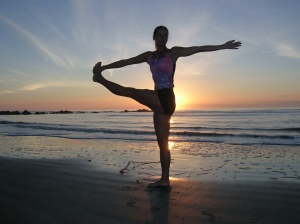
Let’s look at things that you have probably experienced to help you understand this application of opposites. The first thing I think of is a swing – if you pull to hard with your right arm it immediately makes you swing crooked. How about this… why does someone limp? Because one leg is doing more of the work. Injury or weakness sets in motion a change in their gate. It’s like trying to push a grocery cart with one hand, or riding a bike with one hand. You can do these things, but you should notice that you have to do twice the amount of work and twice the amount of correcting. Where if you would use duality to your favor, you would be exerting less effort. You’d be more efficient and hence experience better balance. Harmony comes through equally applying effort and resistance to all your muscles that are set up as pairs.
You have two groups of muscles – the agonist and the antagonist. The antagonist resist what the agonist is trying to do. When the antagonist resist equal to the effort, the movement is smooth and balanced. The sooner we come to realize this the easier life becomes and the more we learn to ride the duality gracefully. It plays out like this – the Quadriceps oppose the action of the hamstrings and vice versa. Just like the opposite of being lazy, is hard work. Duality exists everywhere. Because it’s such an ingrained part of our life, we forget how these forces can work together harmoniously.
If yoga students would take a greater interest in the way their body works, they would find themselves in a state of auto-correction all the time. They would see that the adjustments that their teachers are making can be made with their own applied effort of the right muscle. As things go, there is either an excessive amount of energy or deficient amount. Tightness is too much energy, where as looseness is too little. Here is an example from one of my most favorite yoga asanas – Urdhva Dhanurasana; if your quadriceps are stiff and tight which means they are short, and at the same time your hamstrings are weak and slack it is no surprise that you would struggle to get up off the ground. And that is just one example, keep in mind you have 640 muscles in your body. Take that idea and apply it to 10/12 more pairs of muscle and then you might begin to understand this amazing kinetic chain that you walk around in all day. This might give you a better understanding to why upward bow is difficult, but not impossible.
When our body is in harmony it feels easy to be human; to be alive, vibrant and capable of some of the craziest looking yoga asanas. At 42 I am still surprising myself. I am still taking risk with my self implied limitations. The space shuttle has put astronauts out there to explore uncharted territories and to continually make new discoveries. Your body is capable of shuttling you to new discoveries. It is in the space of disbelief that you will find that you are pushing yourself into new territories.
Pattabhi Jois was said to have much “Gravitas, meaning his energy pulled people towards him, that what he was putting out was magnetic. Find something that is powerful enough to rotate around, the way the sun is powerful enough to keep our planet in orbit. I have found that Yoga is my sun. It keeps me moving, it keeps me illuminated and well balanced. Yoga is my anchor and my engine all at the same time. I can PULL myself back down to earth with yoga or I can PUSH myself to shoot for the stars. But it’s only going to work if I know how to push and pull myself in all manners of speaking.
Good luck and I hope you find lift off in 5, 4, 3, 2, 1.
Why do I run, when it ruins my yoga?
Just the other day when I was teaching a class, I compared doing an hour and a half of yoga to that of running 9 miles. Now anyone who has ever run 9 miles is thinking it’s an over statement, and maybe it is, but I shall explain my line of thinking. All things fitness that seem impossible had their start in the “I can’t do that” vocabulary. But they eventually move towards more of the poker language “I’ll see your 10 pull-ups and add 2”, or “I’ll see your 5 miles and add 5 more.” It’s how you get to the crazy idea of running a marathon. The day that you go out for a run and 10 seems easy is the day you start thinking a 1/2 marathon at 13 miles might not be so bad. For all the people who tell me they can’t do yoga because they can’t touch their toes I just want to say “Well, I couldn’t run a marathon either, until I trained for it.”
Runners tend to gravitate towards my classes and teaching style, for one main reason : I don’t chastise them for being runners. If anything, I praise them for it and ask them when their next race is. I also incorporate a lot of great poses that deal with runner specific over-use injuries. But I also don’t sugar coat it with runners. The truth is, running will not make your physical practice of asana better, but yoga will definitely make your running better, physically speaking. As long as runners can make peace with that idea, it will make it a whole lot easier to push through 1st series ashtanga yoga for 90 minutes. You are bound to be tight, but without yoga you will only get tighter and probably experience more injuries that will sideline you.
So my comparing 90 mins of ashtanga yoga to 90 minutes of running was to make the point that they both take about the same amount of time to accomplish, and that during both you will have to overcome the quitter’s mind. That during 90 minutes of either activity you are probably going to wonder “What was I thinking to do 90 minutes of yoga/running.” Something is going to hurt, some posture, or mile is going to be brutal, and you might start to lose your motivation. When doing anything physical you are going to run up against that voice in your head that is the pessimist, the nay-sayer, the weakling. This is where running and yoga are similar. They are both a battle of the mind, more than a battle of the body. Your body can do just about anything. Hence the reason why the New York City Marathon has 50,000 competitors , the Marine Corp has 30,000 and the Chicago marathon has 40,000, just to name a few. 1% of those people are competing against each other, while the other 99% are competing against the weakest version of their self. The nay-sayer voice that around mile 16 loves to tell you, “You can’t do it.”, is the same voice in yoga that will try to tell you you can’t come up out of a backbend either. The voice is the same, it comes from the same place and can be put to rest the same way no matter if it’s running or yoga. As my teacher, Tim Miller, likes to say “Experience is the remover of doubt.” Every time I run 5 miles, it erases the doubt that I can’t run 6. Every time I run 6, it erases the doubt that I can’t do 7. This can carry on until the 26th mile is finished.
This is how I see the similarities between running 9 miles and ashtanga yoga; the surya namaskars are equivalent to the first mile of any run you go on. It’s the warm up mile, where you find your legs and the rhythm of your breathing. The standing poses are equivalent to a 5k (3 miles), it’s enough of a run on a busy day. The seated postures, up to Marichyasana are equal to about 5 miles. Right in the heart of what are commonly called the speed pump poses in ashtanga there is navasana, bhujapidasana, kurmasana. These are like mile 6, where you start second guessing yourself, and this crazy idea of staying fit. Mile 7 of a 9 mile run starts to smooth out just a bit as you start thinking you’re in the home stretch. Just like the poses baddha konasana, upavishta konasana, and supta padangsthasana do in yoga. You might think backbends are mile 9, but they are only mile 8, you must save enough energy after backbends to complete your inversions and come in strong to savasana. Savasana is equivalent to the cool down after a long run. I can tell you from experience, you don’t just sit down after a long run, or you will quickly stiffen up. You will struggle just to get your shoes off later, if you don’t incorporate a good cool down. Savasana is necessary and so is a good cool down walk after a long run.
I think this is why for years now I have loved practicing ashtanga yoga, and I continue to be a runner. I was a runner long before I was a yogi – I am a distance runner at heart. I like the rhythm of my breathing, I like the rhythm of my legs and arms working together, and I love how my pessimistic mind doesn’t win out. Most runs and most yoga practices I conquer my negativity. I push through the rough spots and I always come out on the other end better for it. Running may be making my yoga practice harder, tighter, but I know that what I conquer while running makes me a better yogi in mental capacity. While yoga makes me a better runner in physical capacity. There is no doubt in my mind that they both make me better spiritually. Staring down your weakness has a profound way of changing you.
Not once in 4 marathons have I hit the infamous “wall” (Mile 21), which in no way means I’m discrediting it. I just happen to run slow enough and have conditioned my mind enough into an “I can” attitude over “I can’t.” Plus to be honest I haven’t run a single marathon trying to beat another person, or a previous time. Simply put, I run them just for the sake of finishing and for once more tackling my inner demons that love to tell me “No”. I remove my doubts by doing the things that I thought couldn’t be done.
So if you’re a runner and haven’t yet tried yoga, I strongly advise you do. Now! Put on your running shoes and head straight over to a studio near you. If you can, find Ashtanga yoga. I think you will like the similarities I just mentioned. I am not telling you it will be easy. I’m being completely honest telling you it’s hard. Running tightens you, it’s gonna be brutal, but it will save you from injuries and even burn-out. It will also give your running longevity. I foresee myself being a runner for just as long as I am a yogi. This is good place to insert my favorite Forrest Gump quote and no it’s not “Run Forest, Run.”, it’s “We was like peas and carrots.” For me, yoga is the peas and running is the carrots. Let’s see if this works “Do yoga, Forest, do yoga!” Nope, it doesn’t work, but I hope I have made my point.
Postures I suggest for runners:
Supta padangustasana (reclining hand to toe pose) – One of the best stretches for the hamstrings
Virsasana/Supta virsasna if appropriate (Hero’s pose. reclining hero’s) – for the quads and shins. If you recline in this one it is great for the psoas
Gomukasana (Cow face pose)- for the external hip rotators
Malasana (Garland pose) – for the lower back and feet
Halasana (Plough pose) – for the upper back and hamstrings
Agni Stambhasana (Fire log pose)- for the glutes and IT band.
Urdhva Dhanurasana (Upward bow pose)- for the whole front body. Modify it by lying over a stability ball – it is just as good for you.
